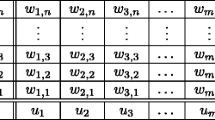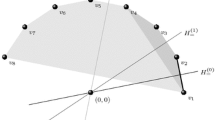Abstract
A new proof of the characterization of the Chinese postman polyhedra is given. In developing this proof, a theorem of Gomory about homomorphic lifting of facets for group polyhedra is generalized to subproblems. Some results for the Chinese postman problem are generalized to binary group problems. In addition, a connection is made between Fulkerson's blocking polyhedra and a blocking pair of binary group problems. A connection is also developed between minors and lifting of facets for group problems.
Similar content being viewed by others
References
J.A. Aráoz, “Polyhedral neopolarities”, Ph.D. Thesis, Department of Computer Science and Applied Analysis, University of Waterloo (Waterloo, Ontario, 1973).
J.A. Aráoz and E.L. Johnson, “Some results on polyhedra of semigroup problems“,SIAM Journal on Algebraic and Discrete Methods 2 (1981) 244–258.
J.A. Aráoz and E.L. Johnson, “On facets and mappings for non-abelian group problems“,SIAM Journal on Algebraic and Discrete Methods 6 (1985) 171–188.
R.E. Bixby and W.H. Cunningham, “Converting linear programs to network problems“,Mathematics of Operations Research 5 (1980) 321–357.
J. Edmonds, “Paths, trees, and flowers“,Canadian Journal of Mathematics 17 (1965) 449–467.
J. Edmonds, “Maximum matching and a polyhedron with 0–1 vertices“,Journal of Research of the National Bureau of Standards Section B69 (1965) 125–130.
J. Edmonds and E.L. Johnson, “Matchings, Euler tours and the Chinese postman“,Mathematical Programming 5 (1973) 88–124.
D.R. Fulkerson, “Blocking polyhedra“, in: B. Harris, ed.,Graph theory and its applications (Academic Press, New York, 1970) pp. 93–112.
G.E. Gastou, “On facets of integer programming polyhedra”, Ph.D. Thesis, Administrative Sciences Department, Yale University (New Haven, CT, 1982).
R. Giles, “Adjacency on the postman polyhedron”, Report No. 79128-OR, Institute for Operations Research, Universität Bonn (Bonn, 1979).
R.E. Gomory, “Some polyhedra related to combinatorial problems“,Linear Algebra and Its Applications 2 (1969) 451–558.
M. Grötschel and W.R. Pulleyblank, “Weakly bipartite graphs“,Operations Research Letters 1 (1981) 23–27.
E.L. Johnson, “On cut-set integer polyhedra“,Cahiers du Centre d'Etudes de Recherche Operationelle 17 (1975) 235–252.
E.L. Johnson, “Integer programming: Facets, subadditivity and duality for group and semigroup problems”, CBMS-NSF Regional conference series in Applied Mathematics 32 (Society for Industrial and Applied Mathematics, Philadelphia, PA, 1980).
E.L. Johnson, “On the generality of the subadditive characterization of facets“,Mathematics of Operations Research 6 (1981) 101–112.
A. Lehman, “A solution of the Shannon switching game“,SIAM Journal of Applied Mathematics 12 (1964) 687–725.
A. Lehman, “On the width-length inequality“,Mathematical Programming 17 (1979) 403–417.
A. Lehman, “Matroids and ports“,Notices of the American Mathematical Society 12 (1965) 342.
Mei-ko Kwan, “Graphic programming using odd or even points“,Chinese Mathematics 1 (1962) 273–277.
M.W. Padberg, “On the facial structure of set packing polyhedra“,Mathematical Programming 5 (1973) 199–215.
W.R. Pulleyblank, “The faces of matching-polyhedra”, Ph.D. Thesis, University of Waterloo (Waterloo, Ontario, 1974).
P.D. Seymour, “Matroids with the max-flow min-cut property“,Journal of Combinatorial Theory Series B 23 (1977) 189–222.
P.D. Seymour, “On multi-colourings of cubic graphs, and conjectures of Fulkerson and Tutte“,Proceedings of the London Mathematical Society 38 (1979) 423–460.
P.D. Seymour, “Decomposition of regular matroids“,Journal of Combinatorial Theory Series B 28 (1980) 305–359.
P.D. Seymour, “On Tutte's characterization of graphic matroids“,Annals of Discrete Mathematics 8 (1980) 83–90.
W.T. Tutte, “Lectures on matroids“,Journal of Research of the National Bureau of Standards Section B 69 (1965) 1–47.
W.T. Tutte, “An algorithm for determining whether a given binary matroid is graphic“,Proceedings of the American Mathematical Society 11 (1960) 903–917.
H. Whitney, “Non-separable and planary graphs“,Transactions of the American Mathematical Society 34 (1932) 339–362.
Author information
Authors and Affiliations
Rights and permissions
About this article
Cite this article
Gastou, G., Johnson, E.L. Binary group and Chinese postman polyhedra. Mathematical Programming 34, 1–33 (1986). https://doi.org/10.1007/BF01582160
Received:
Revised:
Issue Date:
DOI: https://doi.org/10.1007/BF01582160




